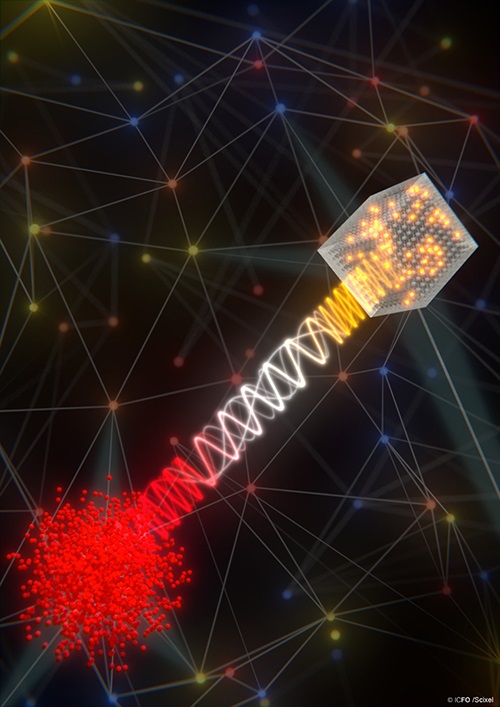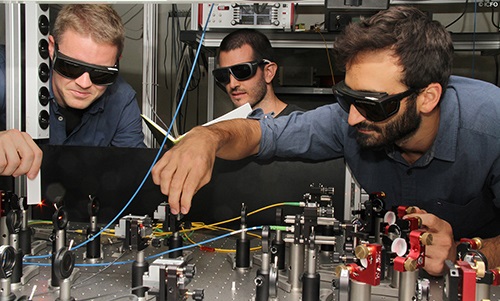23 November 2017
ICFO researchers report the first demonstration of an elementary link of a hybrid quantum information network, using a cold atomic cloud and a doped crystal as quantum nodes and single photons as information carriers.
In a recent study, published in Nature, ICFO researchers Nicolas Maring, Pau Farrera, Dr. Kutlu Kutluer, Dr. Margherita Mazzera, and Dr. Georg Heinze led by ICREA Prof. Hugues de Riedmatten, have achieved an elementary “hybrid” quantum network link and demonstrated for the first time photonic quantum communication between two very distinct quantum nodes placed in different laboratories, using a single photon as information carrier.
The key elements of a Quantum Information Network are quantum nodes, that store and process the information, made up of matter systems like cold atomic gases or doped solids, among others, and communicating particles, mainly photons. While photons seem to be perfect information carriers, there is still uncertainty as to which matter system could be used as network node, as each system provides different functionalities. Therefore, the implementation of a hybrid network has been proposed, searching to combine the best capabilities of different material systems.
Past studies have documented reliable transfers of quantum information between identical nodes, but this is the first time this has ever been achieved with a “hybrid” network of nodes. The ICFO researchers have been able to come up with a solution to making a hybrid quantum network work and solve the challenge of a reliable transfer of quantum states between different quantum nodes via single photons. A single photon needs to interact strongly and in a noise-free environment with the heterogeneous nodes or matter systems, which generally function at different wavelengths and bandwidths. As Nicolas Maring states ”it’s like having nodes speaking in two different languages. In order for them to communicate, it is necessary to convert the single photon’s properties so it can efficiently transfer all the information between these different nodes.”

Schematic illustration of a hybrid information network.
Credit: ICFO/Scixel
In their study, the ICFO researchers used two very distinct quantum nodes: the emitting node was a laser-cooled cloud of Rubidium atoms and the receiving node a crystal doped with Praseodymium ions. From the cold gas, they generated a quantum bit (qubit) encoded in a single photon with a very-narrow bandwidth and a wavelength of 780 nm. They then converted the photon to the telecommunication’s wavelength of 1552 nm to demonstrate that this network could be completely compatible with the current telecom C-band range. Subsequently, they sent it through an optical fiber from one lab to the other. Once in the second lab, the photon’s wavelength was converted to 606 nm in order to interact correctly and transfer the quantum state to the receiving doped crystal node. Upon interaction with the crystal, the photonic qubit was stored in the crystal for approximately 2.5 microseconds and retrieved with very high fidelity.
The results of the study have shown that two very different quantum systems can be connected and can communicate by means of a single photon. As ICREA Prof at ICFO Hugues de Riedmatten comments, “being able to connect quantum nodes with very different functionalities and capabilities and transmitting quantum bits by means of single photons between them represents an important milestone in the development of hybrid quantum networks”. The ability to perform back- and forth-conversion of photonic qubits at the telecom C-band wavelength shows that these systems would be completely compatible with the current telecom networks.















